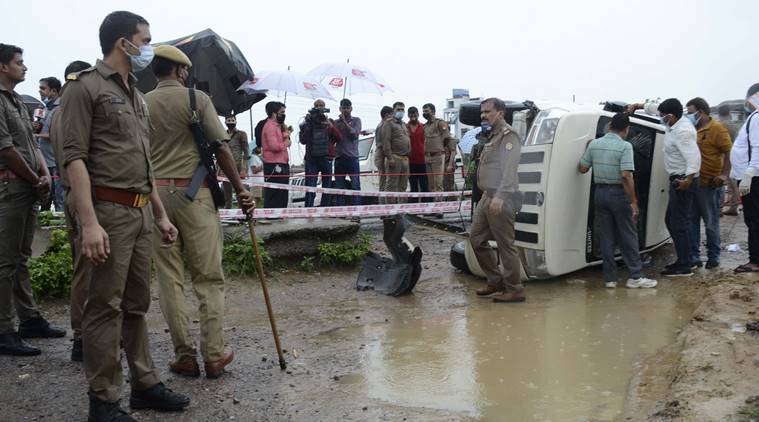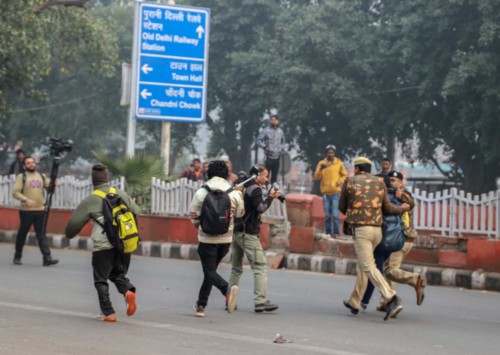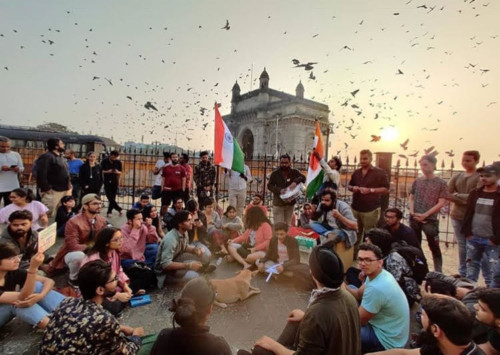Vikas Dubey encounter, latest example of blatant extrajudicial killing in India

Police officers cordon the site where Vikas Dubey was killed near Kanpur, India, on July 10 (AP Photo)
In yet another serious violation of basic human rights, the extrajudicial killing of notorious gangster Vikas Dubey is cold blooded murder by a police force that leaves little to distinguish it from gangs roaming the badlands.
A far more credible plot is scripted by producers of third-grade Bollywood thriller films. The killing of Vikas Dubey was one incident that had been predicted not just by many journalists, but also by scores of people on social media from the time news reports emerged that he had been arrested in Madhya Pradesh.
Hence, few would have been surprised when news emerged that Dubey had been killed early in the morning while he was trying to flee after one of the cars in the police convoy carrying him overturned near Kanpur as a ‘herd of cows and buffaloes suddenly came on the road’. At the end, perhaps, the UP police need not even have tried to hide behind the flimsy cover-up tale that they managed to come up with.
‘‘The killing has all the signs of an extrajudicial execution. It is inconceivable that the man would be in the custody of the Uttar Pradesh police one minute and dead the next. It’s quite possible that the police were in a revengeful mood. Because of the killing of their colleagues, but the feeling of revenge is a misplaced feeling in a professional police force,’’ says Colin Gonsalves, a senior advocate at the Supreme Court of India and founder of New Delhi-based Human Rights Law Network that tries to provide assistance to victims of rights violations across the country.
After all, Vikas Dubey’s murder was not the first such killing by the Uttar Pradesh police, especially since the government of Yogi Adityanath took charge. Pretty much like Filipino President Rodrigo Duterte, Adityanath has let loose his police on a killing spree since coming to power three years ago. Dubey’s murder was 119th killing by the police since then and Adityanath has staunchly stood by the police even when there were clear indications of the killings being simply cold-blooded murders.
Not just the UP government, but all institutional checks on the police seem to have simply stood by and watched the events unfold in the killing fields of the country’s most populous state that has also been its worst-governed for decades. Be it the state human rights commission, the national human rights commission, or even the judiciary, none even tried to hold the UP government accountable or simply to get them to rein in their band of armed killers.
For the record, the government does try to whitewash the killings. It has ordered magisterial inquiries in most cases and these have been completed in 74 encounter cases where deaths occurred. Not surprisingly, the police have got a clean chit in all. Records show that in all, there have been 6,145 operations in which 119 accused have died and 2,258 others injured. In these operations, 13 policemen lost their lives which include the eight near Kanpur last week. In their defence, the police say a total of 885 policemen have been injured in these encounters.
Gonsalves says that most of the times the governments tend to play the rules and not follow the guidelines clearly laid down by the law in all the cases of police encounters with criminals. ‘‘What needs to be done is, under the law there is a 2005 amendment in respect of killings in custody, amendments in the Criminal Procedure Code and these require that a judicial magistrate and not an executive magistrate, a judicial magistrate is a step higher and is a judicial officer, an executive magistrate is not a judge, so the judicial magistrate is required to conduct an enquiry under Section 167 1A of CrPC. The Uttar Pradesh government never does these things. They get an executive magistrate to rubber stamp these killings. Now in this case it would be interesting if someone would call the police and ask them if any enquiry is conducted and by whom. And I think it is almost certain that it would not be done by a judicial magistrate having jurisdiction,’’ he says.
‘‘It is a sign that how these police have become, because the Uttar Pradesh administration led the charge in the country for the killings of people without taking them to trial. The judiciary has not been able to stand firm and process these officers, so they have become very emboldened to kill people as they choose. It’s a sign of complete breakdown of the law and order situation in Uttar Pradesh,’’ adds Gonsalves.
Indeed, lawlessness has long ruled Uttar Pradesh, which, with a population of 230 million, is one of the most impoverished states in India. It is also considered one of the most lawless states with high incidences of armed robberies, kidnappings for ransom and crimes against women, according to the National Crime Record Bureau.
Unfortunately for India, extra-judicial killings are not restricted to UP. Over the decades, police all over the country have been involved in hundreds of incidents where they have killed suspects and very often innocent persons and tried to build a case of encounter. Similarly, in the 1980s-1990s, the Mumbai police had special units that were meant for killing alleged gangsters in encounters and hundreds of people were killed. Similarly, during the same period when Punjab was in the grip of terrorist violence, the state police is alleged to have killed over 10,000 persons that it called terrorists, but in hundreds of cases the dead person’s families claimed they had been killed in cold-blood without any evidence.
The police have become emboldened as not only do they get away scot-free from these crimes but are very often rewarded and awarded for these actions. The government, for instance, gives out of turn promotion and cash incentives to the teams involved in these encounters and they also become heroes in the society as many people see them doing the job of cleaning up the Indian society by killing the criminals.
The hero-worshipping is not limited to real life, many a times they are also projected as heroes on the silver screen with big budget films made on them and their ‘heroic’ acts. Amidst all the hero-worshipping, the people, the media and even the judiciary seem to cast aside the fact that all the killings are suspect unless they have been properly investigated and the real story established.
This hero-worshipping and the fact of getting away with cold-blooded murders is the key reason behind police getting bolder by the day and killing at will. It is such in December last year, police shot dead four men suspected of raping and killing a young female veterinarian in southern India after investigators took them to the crime scene. Human rights groups have been calling for investigations into the deaths.
Gonsalves says that the National Human Rights Commission and the state human rights commissions have been asleep for many years. ‘‘But the NGOs and civil society have been awake and have been monitoring this for a long time. So they have been doing very good work in monitoring executions in Uttar Pradesh. But nobody is willing to listen to them. And their own lives come under threat but they are doing the best they can under the situation. And they need support from civil society, they need financial support to do their work but they are doing it under a situation where the bullet can put an end to their life in a minute,’’ he cautions.
Though the judiciary is fully empowered to take up such cases suo-moto, however, this has now become a very rare practice. ‘‘I don’t think the judiciary is at all interested. Probably it will be said that the man was a criminal and he deserved to die. But if you think like that and if you allow the police to execute in cold blood, even a criminal, it’s the beginning of the end. It’s a long downward slide to lawlessness,’’ forewarns Gonsalves.











